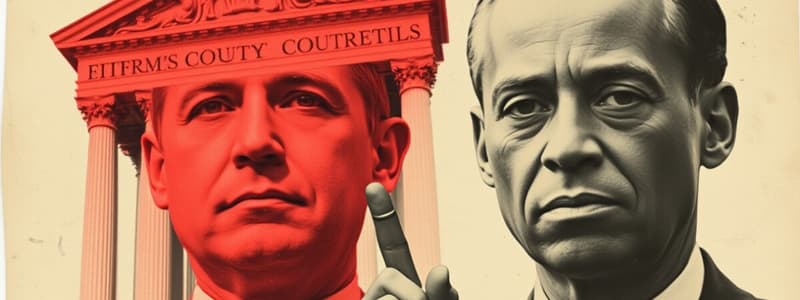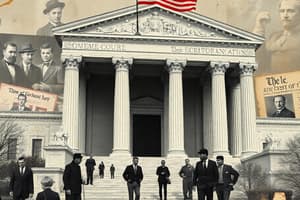Podcast
Questions and Answers
How did the verdict in Brown v. Board of Education relate to the verdict in Plessy v. Ferguson?
How did the verdict in Brown v. Board of Education relate to the verdict in Plessy v. Ferguson?
It set a new legal precedent on the issue of segregation.
Why was Homer Plessy arrested?
Why was Homer Plessy arrested?
He sat down in a train's whites-only car.
What factor do Plessy v. Ferguson, Brown v. Board of Education, and Regents of California v. Bakke have in common?
What factor do Plessy v. Ferguson, Brown v. Board of Education, and Regents of California v. Bakke have in common?
All three cases went to the Supreme Court for ruling.
Compared with the decision in Plessy v. Ferguson, what does the Brown v. Board of Education opinion refute?
Compared with the decision in Plessy v. Ferguson, what does the Brown v. Board of Education opinion refute?
What impact was affirmative action designed to have?
What impact was affirmative action designed to have?
Which term is defined as 'promoting minority inclusion in educational and employment opportunities'?
Which term is defined as 'promoting minority inclusion in educational and employment opportunities'?
How did the decision in Regents v. Bakke affect individual rights?
How did the decision in Regents v. Bakke affect individual rights?
Which of these statements was implied by the decision in Brown v. Board of Education?
Which of these statements was implied by the decision in Brown v. Board of Education?
What does the term 'mandate' mean in terms of civil rights and liberties?
What does the term 'mandate' mean in terms of civil rights and liberties?
How does the Brown v. Board of Education case relate to the concept of federalism?
How does the Brown v. Board of Education case relate to the concept of federalism?
Why did Allan Bakke file a lawsuit?
Why did Allan Bakke file a lawsuit?
What were affirmative action programs originally designed to encourage?
What were affirmative action programs originally designed to encourage?
Which of these actions would be considered an act of civil disobedience?
Which of these actions would be considered an act of civil disobedience?
When Chief Justice Earl Warren stated, 'A sense of inferiority affects the motivation of a child to learn,' what was he essentially stating?
When Chief Justice Earl Warren stated, 'A sense of inferiority affects the motivation of a child to learn,' what was he essentially stating?
What was the Supreme Court in the Brown case saying to the Court of the Plessy case in 1896?
What was the Supreme Court in the Brown case saying to the Court of the Plessy case in 1896?
Study Notes
Major Supreme Court Cases and Civil Rights
- Brown v. Board of Education established a precedent that overturned segregation, rejecting the "separate but equal" doctrine identified in Plessy v. Ferguson.
- Plessy v. Ferguson involved Homer Plessy's arrest for sitting in a whites-only train car, highlighting the era's segregation laws.
- Significant cases like Plessy v. Ferguson, Brown v. Board of Education, and Regents of California v. Bakke all advanced to the Supreme Court and reinforced civil rights, but they also represented various challenges against racial discrimination.
- The Supreme Court's decision in Brown v. Board of Education signaled a rejection of the belief that segregation was harmless or equal, stating that it can induce feelings of inferiority among affected groups.
Affirmative Action
- Affirmative Action refers to policies aimed at improving opportunities for minority groups through practices like setting quotas for admissions and hiring to foster diversity.
- It was initially conceived to address historical injustices and promote minority representation in educational and employment sectors.
- The ruling in Regents v. Bakke indicated that while affirmative action was necessary, it could not unfairly disadvantage individuals, affirming the complexity of balancing rights among different racial groups.
Civil Disobedience and Individual Rights
- Actions like sit-ins represent forms of civil disobedience, challenging unjust laws and advocating for civil rights through nonviolent protests.
- Allan Bakke sued for admission rights, claiming discrimination based on race, showcasing continued struggles against racial inequality in education.
Key Terminology
- "Mandate" in the context of civil rights signifies an authoritative requirement for compliance with policies promoting equality.
- The phrase "a sense of inferiority affects the motivation of a child to learn," as articulated by Chief Justice Earl Warren, underscores the psychological impact of discrimination on educational achievement.
Historical Context and Federalism
- The Brown v. Board of Education case brought the federal government's role in enforcing civil rights under the spotlight, highlighting tension between state laws and federal mandates regarding equality and justice.
Studying That Suits You
Use AI to generate personalized quizzes and flashcards to suit your learning preferences.
Description
This quiz explores landmark Supreme Court cases that shaped civil rights, focusing on decisions like Brown v. Board of Education and Plessy v. Ferguson. It examines how these rulings addressed segregation and the implementation of affirmative action policies to enhance opportunities for minority groups. Test your knowledge of these pivotal legal milestones!




